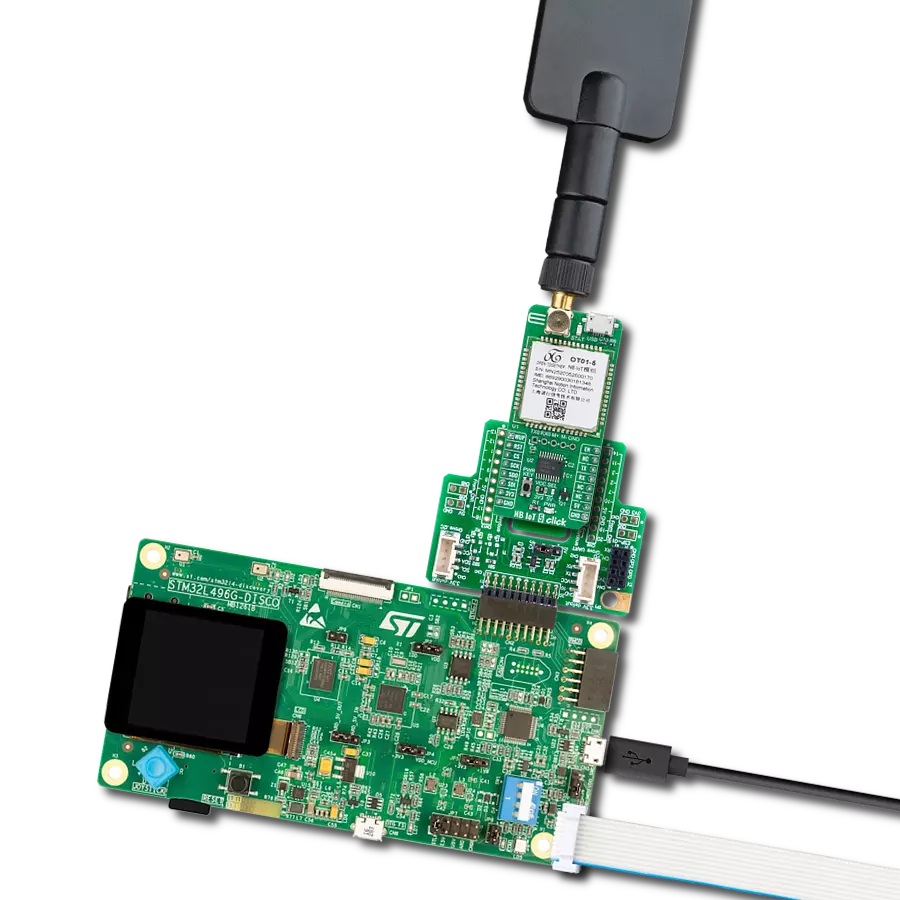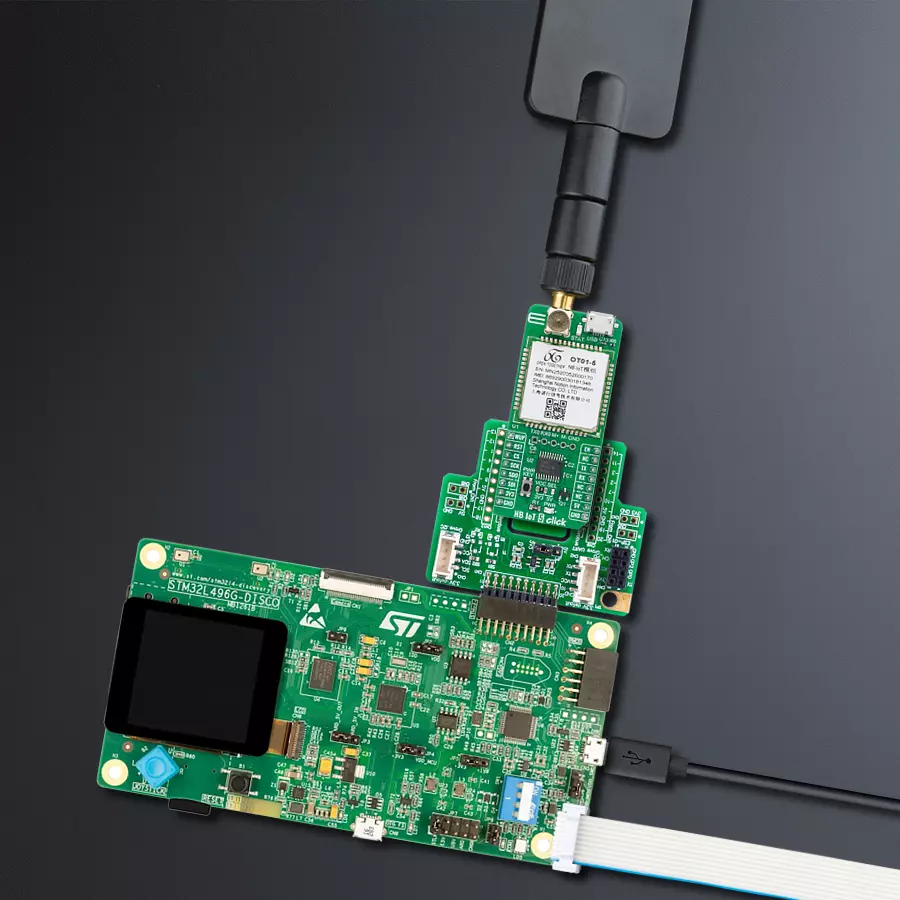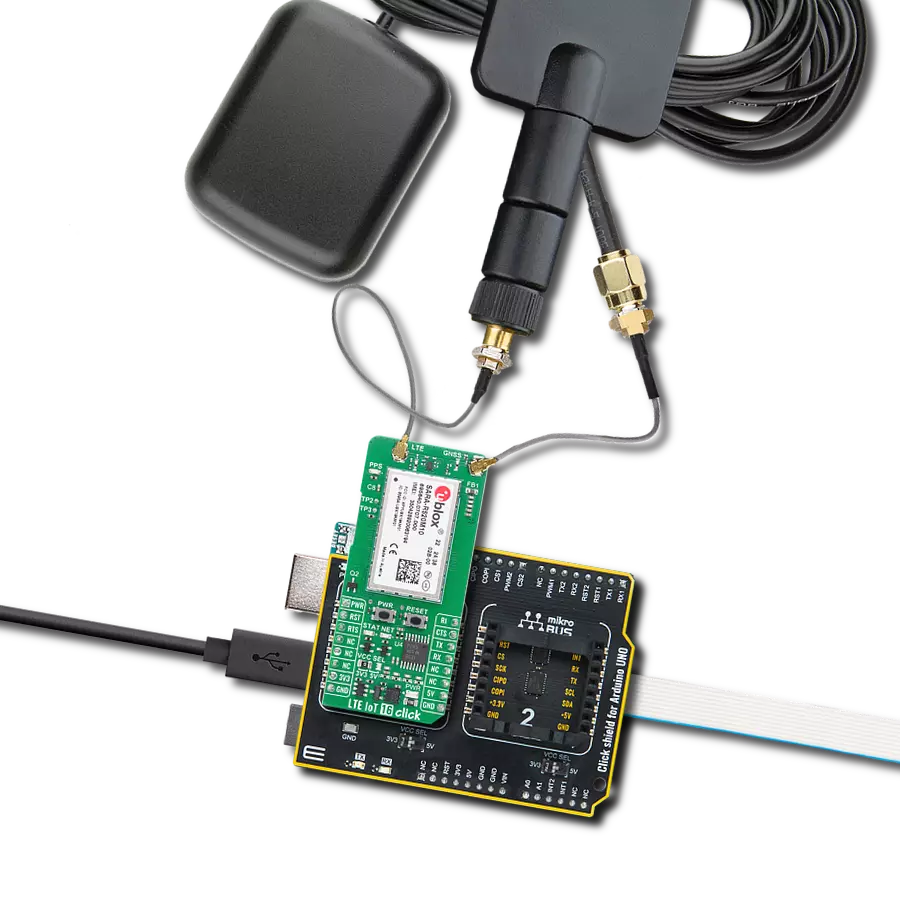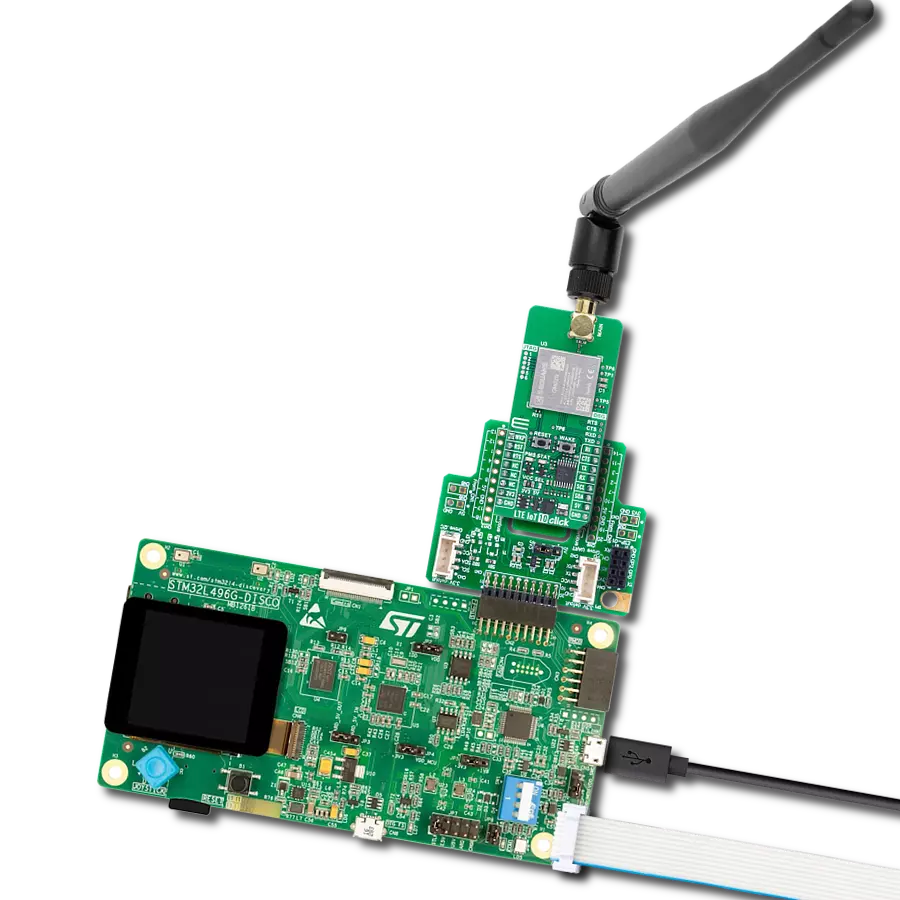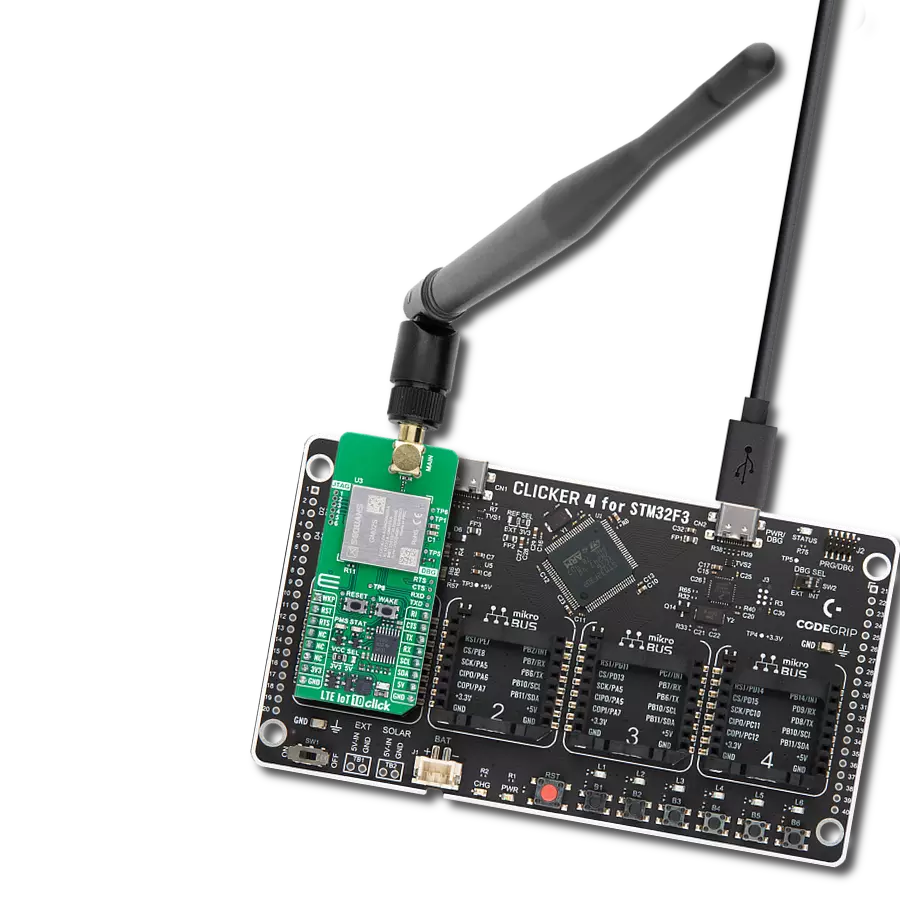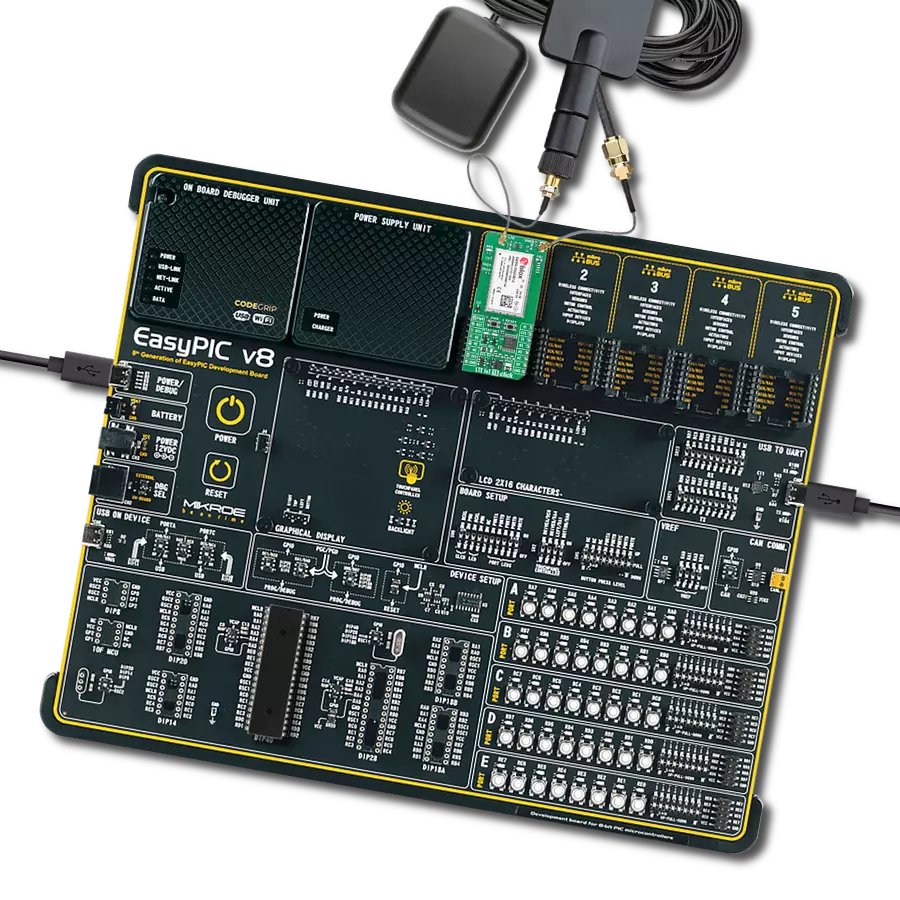拥抱NB-IoT的智能解决方案和智能连接,开启无限可能的世界,提升您的物联网应用。
A
A
硬件概览
它是如何工作的?
NB IoT 5 Click基于OT01-5,这是一款高性能窄带物联网通用无线通信模块,具有极低的功耗,允许电池寿命约为十年。它支持全球频段,如3GPP R13(NB1)和R14(NB2)的1 / 2 / 3 / 5 / 8 / 19 / 20。它还提供了多种接口,包括UART和SPI,以及UDP/TCP、CoAP、LWM2M等协议栈。除了内部的电机驱动设计,这些协议允许使用NB技术进行数据和短信传输,使该模块成为构建物联网应用和智能燃气和水表的理想选择,无需外部微控制器单元。此Click板™有两种启动方式:通过mikroBUS™插座上的EN引脚或按下PWRKEY按钮超过3秒。板载标记为PWRKEY的按钮通过mikroBUS™插座的
PWM引脚进行路由,代表点火(开机)按钮。此功能由标记为STAT的黄色二极管显示,指示设备的操作状态。NB IoT 5 Click使用UART接口作为默认通信协议与MCU通信,用户还可以选择使用其他接口,如SPI,自己配置模块并编写库。它支持自动波特率检测,默认配置下工作于115200 bps,用于数据传输和与主机MCU交换AT命令。此外,它还有一个额外的接口,用于固件升级、软件调试、日志捕获,甚至用作电机驱动。除了这些功能,OT01-5还使用了几个连接到mikroBUS™插座的GPIO引脚。WUP引脚通过mikroBUS™的AN引脚进行路由,表示用于唤醒设备的唤醒功能,而mikroBUS™插座上的RST引脚
通过将该引脚置于逻辑低状态可以执行硬件复位功能。此Click板™还具有一个micro USB连接器,允许模块通过个人计算机供电和配置。NB IoT 5 Click拥有一个阻抗为50Ω的SMA天线连接器。此Click板™可以连接合适的天线,例如MIKROE提供的LTE平板旋转天线。除了SMA连接器,它还有一个Nano-SIM卡插槽,提供多种连接和接口选项。此Click板™可以通过标记为VCC SEL的跳线设置为3.3V和5V MCU,适当的电压电平转换由电压电平转换器TXS0108E进行。这样,既允许3.3V也允许5V的MCU正确使用通信线路。此外,此Click板™配备了包含函数和示例代码的库,可用作进一步开发的参考。
功能概述
开发板
32L496GDISCOVERY Discovery 套件是一款功能全面的演示和开发平台,专为搭载 Arm® Cortex®-M4 内核的 STM32L496AG 微控制器设计。该套件适用于需要在高性能、先进图形处理和超低功耗之间取得平衡的应用,支持无缝原型开发,适用于各种嵌入式解决方案。STM32L496AG 采用创新的节能架构,集成
了扩展 RAM 和 Chrom-ART 图形加速器,在提升图形性能的同时保持低功耗,使其特别适用于音频处理、图形用户界面和实时数据采集等对能效要求较高的应用。为了简化开发流程,该开发板配备了板载 ST-LINK/V2-1 调试器/编程器,提供即插即用的调试和编程体验,使用户无需额外硬件即可轻松加载、调
试和测试应用程序。凭借低功耗特性、增强的内存能力以及内置调试工具,32L496GDISCOVERY 套件是开发先进嵌入式系统、实现高效能解决方案的理想选择。
微控制器概述
MCU卡片 / MCU

建筑
ARM Cortex-M4
MCU 内存 (KB)
1024
硅供应商
STMicroelectronics
引脚数
169
RAM (字节)
327680
使用的MCU引脚
mikroBUS™映射器
“仔细看看!”
Click board™ 原理图

一步一步来
项目组装
实时跟踪您的结果
应用程序输出
1. 应用程序输出 - 在调试模式下,“应用程序输出”窗口支持实时数据监控,直接提供执行结果的可视化。请按照提供的教程正确配置环境,以确保数据正确显示。

2. UART 终端 - 使用UART Terminal通过USB to UART converter监视数据传输,实现Click board™与开发系统之间的直接通信。请根据项目需求配置波特率和其他串行设置,以确保正常运行。有关分步设置说明,请参考提供的教程。

3. Plot 输出 - Plot功能提供了一种强大的方式来可视化实时传感器数据,使趋势分析、调试和多个数据点的对比变得更加直观。要正确设置,请按照提供的教程,其中包含使用Plot功能显示Click board™读数的分步示例。在代码中使用Plot功能时,请使用以下函数:plot(insert_graph_name, variable_name);。这是一个通用格式,用户需要将“insert_graph_name”替换为实际图表名称,并将“variable_name”替换为要显示的参数。

软件支持
库描述
NB IoT 5 Click 演示应用程序使用 NECTO Studio开发,确保与 mikroSDK 的开源库和工具兼容。该演示设计为即插即用,可与所有具有 mikroBUS™ 插座的 开发板、入门板和 mikromedia 板完全兼容,用于快速实现和测试。
示例描述
该应用示例展示了设备通过标准 "AT" 指令连接至网络并发送 SMS 或 TCP/UDP 消息的能力。
关键功能:
nbiot5_cfg_setup- 配置对象初始化函数。nbiot5_init- 初始化函数。nbiot5_set_sim_apn- 设置 SIM 卡的 APN 参数。nbiot5_send_sms_text- 以文本模式发送短信至指定电话号码。nbiot5_send_sms_pdu- 以 PDU 模式发送短信至指定电话号码。
应用初始化
初始化驱动程序,发送 "AT" 指令测试通信,随后重启设备。
应用任务
应用任务分为以下几个阶段:
NBIOT5_CONFIGURE_FOR_NETWORK:配置设备以连接到网络。NBIOT5_WAIT_FOR_CONNECTION:等待网络注册(通过 CEREG URC 事件指示),然后检查连接状态。NBIOT5_CONFIGURE_FOR_EXAMPLE:根据所选示例配置设备以发送 SMS 或 TCP/UDP 消息。NBIOT5_EXAMPLE:根据所选示例发送短信(PDU 或 TXT 模式)或 TCP/UDP 消息,默认示例为 TCP/UDP 消息。
开源
代码示例
完整的应用程序代码和一个现成的项目可以通过NECTO Studio包管理器直接安装到NECTO Studio。 应用程序代码也可以在MIKROE的GitHub账户中找到。
/*!
* @file main.c
* @brief NB IoT 5 Click Example.
*
* # Description
* Application example shows device capability of connecting to the network and
* sending SMS or TCP/UDP messages using standard "AT" commands.
*
* The demo application is composed of two sections :
*
* ## Application Init
* Initializes the driver, tests the communication by sending "AT" command, and after that restarts the device.
*
* ## Application Task
* Application task is split in few stages:
* - NBIOT5_CONFIGURE_FOR_NETWORK:
* Sets configuration to device to be able to connect to the network.
*
* - NBIOT5_WAIT_FOR_CONNECTION:
* Waits for the network registration indicated via CEREG URC event and then checks
* the connection status.
*
* - NBIOT5_CONFIGURE_FOR_EXAMPLE:
* Sets the device configuration for sending SMS or TCP/UDP messages depending on the selected demo example.
*
* - NBIOT5_EXAMPLE:
* Depending on the selected demo example, it sends an SMS message (in PDU or TXT mode) or TCP/UDP message.
*
* By default, the TCP/UDP example is selected.
*
* ## Additional Function
* - static void nbiot5_clear_app_buf ( void )
* - static err_t nbiot5_process ( void )
* - static void nbiot5_error_check( err_t error_flag )
* - static void nbiot5_log_app_buf ( void )
* - static err_t nbiot5_rsp_check ( uint8_t *rsp )
* - static err_t nbiot5_configure_for_connection( void )
* - static err_t nbiot5_check_connection( void )
* - static err_t nbiot5_configure_for_messages( void )
* - static err_t nbiot5_send_message( void )
*
* @note
* In order for the examples to work, user needs to set the APN and SMSC (SMS PDU mode only)
* of entered SIM card as well as the phone number (SMS mode only) to which he wants to send an SMS.
* Enter valid values for the following macros: SIM_APN, SIM_SMSC and PHONE_NUMBER_TO_MESSAGE.
* Example:
SIM_APN "internet"
SIM_SMSC "+381610401"
PHONE_NUMBER_TO_MESSAGE "+381659999999"
* Make sure the JP2 is removed from the Click board, otherwise, you will need to connect the USB
* so that the module can boot up successfully.
*
* @author Stefan Filipovic
*
*/
#include "board.h"
#include "log.h"
#include "nbiot5.h"
#include "conversions.h"
// Example selection macros
#define EXAMPLE_TCP_UDP 0 // Example of sending messages to a TCP/UDP echo server
#define EXAMPLE_SMS 1 // Example of sending SMS to a phone number
#define DEMO_EXAMPLE EXAMPLE_TCP_UDP // Example selection macro
// SIM APN config
#define SIM_APN "internet" // Set valid SIM APN
// SMS example parameters
#define SIM_SMSC "" // Set valid SMS Service Center Address - only in SMS PDU mode
#define PHONE_NUMBER_TO_MESSAGE "" // Set Phone number to message
#define SMS_MODE "1" // SMS mode: "0" - PDU, "1" - TXT
// TCP/UDP example parameters
#define REMOTE_IP "77.46.162.162" // TCP/UDP echo server IP address
#define REMOTE_PORT "51111" // TCP/UDP echo server port
// Message content
#define MESSAGE_CONTENT "NB IoT 5 Click board - demo example."
// Application buffer size
#define APP_BUFFER_SIZE 256
#define PROCESS_BUFFER_SIZE 256
/**
* @brief Example states.
* @details Predefined enum values for application example state.
*/
typedef enum
{
NBIOT5_CONFIGURE_FOR_NETWORK = 1,
NBIOT5_WAIT_FOR_CONNECTION,
NBIOT5_CONFIGURE_FOR_EXAMPLE,
NBIOT5_EXAMPLE
} nbiot5_example_state_t;
static nbiot5_t nbiot5;
static log_t logger;
/**
* @brief Application example variables.
* @details Variables used in application example.
*/
static uint8_t app_buf[ APP_BUFFER_SIZE ] = { 0 };
static int32_t app_buf_len = 0;
static err_t error_flag;
static nbiot5_example_state_t example_state;
/**
* @brief Clearing application buffer.
* @details This function clears memory of application
* buffer and reset its length and counter.
*/
static void nbiot5_clear_app_buf ( void );
/**
* @brief Data reading function.
* @details This function reads data from device and
* appends it to the application buffer.
* @return @li @c 0 - Some data is read.
* @li @c -1 - Nothing is read.
* See #err_t definition for detailed explanation.
*/
static err_t nbiot5_process ( void );
/**
* @brief Check for errors.
* @details This function checks for different types of
* errors and logs them on UART or logs the response if no errors occured.
* @param[in] error_flag Error flag to check.
*/
static void nbiot5_error_check ( err_t error_flag );
/**
* @brief Logs application buffer.
* @details This function logs data from application buffer.
*/
static void nbiot5_log_app_buf ( void );
/**
* @brief Response check.
* @details This function checks for response and
* returns the status of response.
* @param[in] rsp Expected response.
* @return @li @c 0 - OK response.
* @li @c -2 - Timeout error.
* @li @c -3 - Command error.
* @li @c -4 - Unknown error.
* See #err_t definition for detailed explanation.
*/
static err_t nbiot5_rsp_check ( uint8_t *rsp );
/**
* @brief Configure device for connection to the network.
* @details Sends commands to configure and enable
* connection to the specified network.
* @return @li @c 0 - OK response.
* @li @c -2 - Timeout error.
* @li @c -3 - Command error.
* @li @c -4 - Unknown error.
* See #err_t definition for detailed explanation.
*/
static err_t nbiot5_configure_for_network ( void );
/**
* @brief Wait for connection signal.
* @details Wait for connection signal from CREG URC.
* @return @li @c 0 - OK response.
* @li @c -2 - Timeout error.
* @li @c -3 - Command error.
* @li @c -4 - Unknown error.
* See #err_t definition for detailed explanation.
*/
static err_t nbiot5_check_connection ( void );
/**
* @brief Configure device for example.
* @details Configure device for the specified example.
* @return @li @c 0 - OK response.
* @li @c -2 - Timeout error.
* @li @c -3 - Command error.
* @li @c -4 - Unknown error.
* See #err_t definition for detailed explanation.
*/
static err_t nbiot5_configure_for_example ( void );
/**
* @brief Execute example.
* @details This function executes SMS or TCP/UDP example depending on the DEMO_EXAMPLE macro.
* @return @li @c 0 - OK response.
* @li @c -2 - Timeout error.
* @li @c -3 - Command error.
* @li @c -4 - Unknown error.
* See #err_t definition for detailed explanation.
*/
static err_t nbiot5_example ( void );
void application_init ( void )
{
log_cfg_t log_cfg; /**< Logger config object. */
nbiot5_cfg_t nbiot5_cfg; /**< Click config object. */
/**
* Logger initialization.
* Default baud rate: 115200
* Default log level: LOG_LEVEL_DEBUG
* @note If USB_UART_RX and USB_UART_TX
* are defined as HAL_PIN_NC, you will
* need to define them manually for log to work.
* See @b LOG_MAP_USB_UART macro definition for detailed explanation.
*/
LOG_MAP_USB_UART( log_cfg );
log_init( &logger, &log_cfg );
log_info( &logger, " Application Init " );
// Click initialization.
nbiot5_cfg_setup( &nbiot5_cfg );
NBIOT5_MAP_MIKROBUS( nbiot5_cfg, MIKROBUS_1 );
if ( UART_ERROR == nbiot5_init( &nbiot5, &nbiot5_cfg ) )
{
log_error( &logger, " Application Init Error. " );
log_info( &logger, " Please, run program again... " );
for ( ; ; );
}
nbiot5_process( );
nbiot5_clear_app_buf( );
// Check communication
nbiot5_send_cmd( &nbiot5, NBIOT5_CMD_AT );
error_flag = nbiot5_rsp_check( NBIOT5_RSP_OK );
nbiot5_error_check( error_flag );
// Restart device
#define RESTART_DEVICE "1,1"
nbiot5_send_cmd_with_par( &nbiot5, NBIOT5_CMD_CFUN, RESTART_DEVICE );
error_flag = nbiot5_rsp_check( NBIOT5_RSP_OK );
nbiot5_error_check( error_flag );
log_info( &logger, " Application Task " );
example_state = NBIOT5_CONFIGURE_FOR_NETWORK;
}
void application_task ( void )
{
switch ( example_state )
{
case NBIOT5_CONFIGURE_FOR_NETWORK:
{
if ( NBIOT5_OK == nbiot5_configure_for_network( ) )
{
example_state = NBIOT5_WAIT_FOR_CONNECTION;
}
break;
}
case NBIOT5_WAIT_FOR_CONNECTION:
{
if ( NBIOT5_OK == nbiot5_check_connection( ) )
{
example_state = NBIOT5_CONFIGURE_FOR_EXAMPLE;
}
break;
}
case NBIOT5_CONFIGURE_FOR_EXAMPLE:
{
if ( NBIOT5_OK == nbiot5_configure_for_example( ) )
{
example_state = NBIOT5_EXAMPLE;
}
break;
}
case NBIOT5_EXAMPLE:
{
nbiot5_example( );
break;
}
default:
{
log_error( &logger, " Example state." );
break;
}
}
}
int main ( void )
{
/* Do not remove this line or clock might not be set correctly. */
#ifdef PREINIT_SUPPORTED
preinit();
#endif
application_init( );
for ( ; ; )
{
application_task( );
}
return 0;
}
static void nbiot5_clear_app_buf ( void )
{
memset( app_buf, 0, app_buf_len );
app_buf_len = 0;
}
static err_t nbiot5_process ( void )
{
uint8_t rx_buf[ PROCESS_BUFFER_SIZE ] = { 0 };
int32_t rx_size = 0;
rx_size = nbiot5_generic_read( &nbiot5, rx_buf, PROCESS_BUFFER_SIZE );
if ( rx_size > 0 )
{
int32_t buf_cnt = app_buf_len;
if ( ( ( app_buf_len + rx_size ) > APP_BUFFER_SIZE ) && ( app_buf_len > 0 ) )
{
buf_cnt = APP_BUFFER_SIZE - ( ( app_buf_len + rx_size ) - APP_BUFFER_SIZE );
memmove ( app_buf, &app_buf[ APP_BUFFER_SIZE - buf_cnt ], buf_cnt );
}
for ( int32_t rx_cnt = 0; rx_cnt < rx_size; rx_cnt++ )
{
if ( rx_buf[ rx_cnt ] )
{
app_buf[ buf_cnt++ ] = rx_buf[ rx_cnt ];
if ( app_buf_len < APP_BUFFER_SIZE )
{
app_buf_len++;
}
}
}
return NBIOT5_OK;
}
return NBIOT5_ERROR;
}
static err_t nbiot5_rsp_check ( uint8_t *rsp )
{
uint32_t timeout_cnt = 0;
uint32_t timeout = 120000;
nbiot5_clear_app_buf( );
nbiot5_process( );
while ( ( 0 == strstr( app_buf, rsp ) ) &&
( 0 == strstr( app_buf, NBIOT5_RSP_ERROR ) ) )
{
nbiot5_process( );
if ( timeout_cnt++ > timeout )
{
nbiot5_clear_app_buf( );
return NBIOT5_ERROR_TIMEOUT;
}
Delay_ms ( 1 );
}
Delay_ms ( 100 );
nbiot5_process( );
if ( strstr( app_buf, rsp ) )
{
return NBIOT5_OK;
}
else if ( strstr( app_buf, NBIOT5_RSP_ERROR ) )
{
return NBIOT5_ERROR_CMD;
}
else
{
return NBIOT5_ERROR_UNKNOWN;
}
}
static void nbiot5_error_check ( err_t error_flag )
{
switch ( error_flag )
{
case NBIOT5_OK:
{
nbiot5_log_app_buf( );
break;
}
case NBIOT5_ERROR:
{
log_error( &logger, " Overflow!" );
break;
}
case NBIOT5_ERROR_TIMEOUT:
{
log_error( &logger, " Timeout!" );
break;
}
case NBIOT5_ERROR_CMD:
{
log_error( &logger, " CMD!" );
break;
}
case NBIOT5_ERROR_UNKNOWN:
default:
{
log_error( &logger, " Unknown!" );
break;
}
}
Delay_ms ( 500 );
}
static void nbiot5_log_app_buf ( void )
{
for ( int32_t buf_cnt = 0; buf_cnt < app_buf_len; buf_cnt++ )
{
log_printf( &logger, "%c", app_buf[ buf_cnt ] );
}
}
static err_t nbiot5_configure_for_network ( void )
{
err_t func_error = NBIOT5_OK;
#if ( ( DEMO_EXAMPLE == EXAMPLE_TCP_UDP ) || ( DEMO_EXAMPLE == EXAMPLE_SMS ) )
Delay_ms ( 1000 );
Delay_ms ( 1000 );
Delay_ms ( 1000 );
Delay_ms ( 1000 );
Delay_ms ( 1000 );
// Deregister from network
#define DEREGISTER_FROM_NETWORK "2"
nbiot5_send_cmd_with_par( &nbiot5, NBIOT5_CMD_COPS, DEREGISTER_FROM_NETWORK );
error_flag = nbiot5_rsp_check( NBIOT5_RSP_OK );
func_error |= error_flag;
nbiot5_error_check( error_flag );
// Set SIM APN
nbiot5_set_sim_apn( &nbiot5, SIM_APN );
error_flag = nbiot5_rsp_check( NBIOT5_RSP_OK );
func_error |= error_flag;
nbiot5_error_check( error_flag );
// Enable full functionality
#define FULL_FUNCTIONALITY "1"
nbiot5_send_cmd_with_par( &nbiot5, NBIOT5_CMD_CFUN, FULL_FUNCTIONALITY );
error_flag = nbiot5_rsp_check( NBIOT5_RSP_OK );
func_error |= error_flag;
nbiot5_error_check( error_flag );
#define ENABLE_EPS_REG "2"
nbiot5_send_cmd_with_par( &nbiot5, NBIOT5_CMD_CEREG, ENABLE_EPS_REG );
error_flag = nbiot5_rsp_check( NBIOT5_RSP_OK );
func_error |= error_flag;
nbiot5_error_check( error_flag );
// Automatic registration
#define AUTOMATIC_REGISTRATION "0"
nbiot5_send_cmd_with_par( &nbiot5, NBIOT5_CMD_COPS, AUTOMATIC_REGISTRATION );
error_flag = nbiot5_rsp_check( NBIOT5_RSP_OK );
func_error |= error_flag;
nbiot5_error_check( error_flag );
#endif
return func_error;
}
static err_t nbiot5_check_connection ( void )
{
#if ( ( DEMO_EXAMPLE == EXAMPLE_TCP_UDP ) || ( DEMO_EXAMPLE == EXAMPLE_SMS ) )
#define CONNECTED "+CEREG: 2,1"
nbiot5_send_cmd_check ( &nbiot5, NBIOT5_CMD_CEREG );
error_flag = nbiot5_rsp_check( NBIOT5_RSP_OK );
nbiot5_error_check( error_flag );
if ( strstr( app_buf, CONNECTED ) )
{
Delay_ms ( 100 );
// Check signal quality
nbiot5_send_cmd( &nbiot5, NBIOT5_CMD_CSQ );
error_flag = nbiot5_rsp_check( NBIOT5_RSP_OK );
nbiot5_error_check( error_flag );
#define NO_SIGNAL "99,99"
if ( !strstr( app_buf, NO_SIGNAL ) )
{
Delay_ms ( 1000 );
return error_flag;
}
}
Delay_ms ( 1000 );
return NBIOT5_ERROR;
#endif
return NBIOT5_OK;
}
static err_t nbiot5_configure_for_example ( void )
{
err_t func_error = NBIOT5_OK;
#if ( DEMO_EXAMPLE == EXAMPLE_TCP_UDP )
Delay_ms ( 1000 );
Delay_ms ( 1000 );
Delay_ms ( 1000 );
Delay_ms ( 1000 );
Delay_ms ( 1000 );
#elif ( DEMO_EXAMPLE == EXAMPLE_SMS )
nbiot5_send_cmd_with_par( &nbiot5, NBIOT5_CMD_CMGF, SMS_MODE );
error_flag = nbiot5_rsp_check( NBIOT5_RSP_OK );
func_error |= error_flag;
nbiot5_error_check( error_flag );
#else
#error "No demo example selected"
#endif
return func_error;
}
static err_t nbiot5_example ( void )
{
err_t func_error = NBIOT5_OK;
#if ( DEMO_EXAMPLE == EXAMPLE_TCP_UDP )
uint8_t cmd_buf[ 100 ] = { 0 };
uint8_t * __generic_ptr socket_num_buf = 0;
uint8_t tcp_socket_num[ 2 ] = { 0 };
uint8_t udp_socket_num[ 2 ] = { 0 };
// Create TCP socket.
#define RESPONSE_ESOC "\r\n+ESOC="
#define TCP_PROTOCOL "1,1,1"
nbiot5_send_cmd_with_par( &nbiot5, NBIOT5_CMD_ESOC, TCP_PROTOCOL );
error_flag = nbiot5_rsp_check( NBIOT5_RSP_OK );
func_error |= error_flag;
nbiot5_error_check( error_flag );
socket_num_buf = strstr( app_buf, RESPONSE_ESOC ) + strlen ( RESPONSE_ESOC );
tcp_socket_num[ 0 ] = *socket_num_buf;
// Create UDP socket.
#define UDP_PROTOCOL "1,2,1"
nbiot5_send_cmd_with_par( &nbiot5, NBIOT5_CMD_ESOC, UDP_PROTOCOL );
error_flag = nbiot5_rsp_check( NBIOT5_RSP_OK );
func_error |= error_flag;
nbiot5_error_check( error_flag );
socket_num_buf = strstr( app_buf, RESPONSE_ESOC ) + strlen ( RESPONSE_ESOC );
udp_socket_num[ 0 ] = *socket_num_buf;
// Connect TCP socket to remote IP and port
strcpy( cmd_buf, tcp_socket_num );
strcat( cmd_buf, "," );
strcat( cmd_buf, REMOTE_PORT );
strcat( cmd_buf, ",\"" );
strcat( cmd_buf, REMOTE_IP );
strcat( cmd_buf, "\"" );
nbiot5_send_cmd_with_par( &nbiot5, NBIOT5_CMD_ESOCON, cmd_buf );
error_flag = nbiot5_rsp_check( NBIOT5_RSP_OK );
func_error |= error_flag;
nbiot5_error_check( error_flag );
// Connect UDP socket to remote IP and port
strcpy( cmd_buf, udp_socket_num );
strcat( cmd_buf, "," );
strcat( cmd_buf, REMOTE_PORT );
strcat( cmd_buf, ",\"" );
strcat( cmd_buf, REMOTE_IP );
strcat( cmd_buf, "\"" );
nbiot5_send_cmd_with_par( &nbiot5, NBIOT5_CMD_ESOCON, cmd_buf );
error_flag = nbiot5_rsp_check( NBIOT5_RSP_OK );
func_error |= error_flag;
nbiot5_error_check( error_flag );
// Get message length
uint8_t message_len_buf[ 5 ] = { 0 };
uint16_t message_len = strlen( MESSAGE_CONTENT );
uint16_to_str( message_len, message_len_buf );
l_trim( message_len_buf );
r_trim( message_len_buf );
// Write message to TCP socket
uint8_t byte_buf[ 5 ] = { 0 };
strcpy( cmd_buf, tcp_socket_num );
strcat( cmd_buf, "," );
strcat( cmd_buf, message_len_buf );
strcat( cmd_buf, "," );
for ( uint16_t cnt = 0; cnt < message_len; cnt++ )
{
uint8_to_hex ( MESSAGE_CONTENT[ cnt ], byte_buf );
strcat ( cmd_buf, byte_buf );
}
nbiot5_send_cmd_with_par( &nbiot5, NBIOT5_CMD_ESOSEND, cmd_buf );
error_flag = nbiot5_rsp_check( NBIOT5_RSP_OK );
func_error |= error_flag;
nbiot5_error_check( error_flag );
// Read response
#define RESPONSE_URC "+ESONMI"
error_flag = nbiot5_rsp_check( RESPONSE_URC );
func_error |= error_flag;
nbiot5_error_check( error_flag );
// Parse response
uint8_t response[ 100 ] = { 0 };
uint8_t response_len[ 5 ] = { 0 };
char * __generic_ptr start_response_len_buf = 0;
uint8_t response_len_buf_len = 0;
start_response_len_buf = strstr( app_buf, RESPONSE_URC ) + 10;
response_len_buf_len = strstr( start_response_len_buf, "," ) - start_response_len_buf;
memcpy ( response_len, start_response_len_buf, response_len_buf_len );
memcpy ( response, start_response_len_buf + 3, atoi( response_len ) * 2 );
for ( uint8_t cnt = 0; cnt < atoi( response_len ); cnt++ )
{
response[ cnt ] = hex_to_uint8 ( &response[ cnt * 2 ] );
}
response[ atoi( response_len ) ] = 0;
log_printf( &logger, "Response: %s\r\n", response );
// Write message to UDP socket
strcpy( cmd_buf, udp_socket_num );
strcat( cmd_buf, "," );
strcat( cmd_buf, message_len_buf );
strcat( cmd_buf, "," );
for ( uint16_t cnt = 0; cnt < message_len; cnt++ )
{
uint8_to_hex ( MESSAGE_CONTENT[ cnt ], byte_buf );
strcat ( cmd_buf, byte_buf );
}
nbiot5_send_cmd_with_par( &nbiot5, NBIOT5_CMD_ESOSEND, cmd_buf );
error_flag = nbiot5_rsp_check( NBIOT5_RSP_OK );
func_error |= error_flag;
nbiot5_error_check( error_flag );
// Read response
#define RESPONSE_URC "+ESONMI"
error_flag = nbiot5_rsp_check( RESPONSE_URC );
func_error |= error_flag;
nbiot5_error_check( error_flag );
// Parse response
start_response_len_buf = strstr( app_buf, RESPONSE_URC ) + 10;
response_len_buf_len = strstr( start_response_len_buf, "," ) - start_response_len_buf;
memcpy ( response_len, start_response_len_buf, response_len_buf_len );
memcpy ( response, start_response_len_buf + 3, atoi( response_len ) * 2 );
for ( uint8_t cnt = 0; cnt < atoi( response_len ); cnt++ )
{
response[ cnt ] = hex_to_uint8 ( &response[ cnt * 2 ] );
}
response[ atoi( response_len ) ] = 0;
log_printf( &logger, "Response: %s\r\n", response );
// Close TCP socket
nbiot5_send_cmd_with_par( &nbiot5, NBIOT5_CMD_ESOCL, tcp_socket_num );
error_flag = nbiot5_rsp_check( NBIOT5_RSP_OK );
func_error |= error_flag;
nbiot5_error_check( error_flag );
// Close UDP socket
nbiot5_send_cmd_with_par( &nbiot5, NBIOT5_CMD_ESOCL, udp_socket_num );
error_flag = nbiot5_rsp_check( NBIOT5_RSP_OK );
func_error |= error_flag;
nbiot5_error_check( error_flag );
Delay_ms ( 1000 );
Delay_ms ( 1000 );
Delay_ms ( 1000 );
Delay_ms ( 1000 );
Delay_ms ( 1000 );
#elif ( DEMO_EXAMPLE == EXAMPLE_SMS )
// Check SMS mode
#define CMGF_PDU "+CMGF: 0"
#define CMGF_TXT "+CMGF: 1"
nbiot5_send_cmd_check( &nbiot5, NBIOT5_CMD_CMGF );
error_flag = nbiot5_rsp_check( NBIOT5_RSP_OK );
func_error |= error_flag;
nbiot5_error_check( error_flag );
if ( strstr( app_buf, CMGF_PDU ) )
{
// Send SMS in PDU mode
nbiot5_send_sms_pdu( &nbiot5, SIM_SMSC, PHONE_NUMBER_TO_MESSAGE, MESSAGE_CONTENT );
error_flag = nbiot5_rsp_check( NBIOT5_RSP_OK );
func_error |= error_flag;
nbiot5_error_check( error_flag );
}
else if ( strstr( app_buf, CMGF_TXT ) )
{
// Send SMS in TXT mode
nbiot5_send_sms_text ( &nbiot5, PHONE_NUMBER_TO_MESSAGE, MESSAGE_CONTENT );
error_flag = nbiot5_rsp_check( NBIOT5_RSP_OK );
func_error |= error_flag;
nbiot5_error_check( error_flag );
}
// 30 seconds delay
Delay_ms ( 1000 );
Delay_ms ( 1000 );
Delay_ms ( 1000 );
Delay_ms ( 1000 );
Delay_ms ( 1000 );
Delay_ms ( 1000 );
Delay_ms ( 1000 );
Delay_ms ( 1000 );
Delay_ms ( 1000 );
Delay_ms ( 1000 );
Delay_ms ( 1000 );
Delay_ms ( 1000 );
Delay_ms ( 1000 );
Delay_ms ( 1000 );
Delay_ms ( 1000 );
Delay_ms ( 1000 );
Delay_ms ( 1000 );
Delay_ms ( 1000 );
Delay_ms ( 1000 );
Delay_ms ( 1000 );
Delay_ms ( 1000 );
Delay_ms ( 1000 );
Delay_ms ( 1000 );
Delay_ms ( 1000 );
Delay_ms ( 1000 );
Delay_ms ( 1000 );
Delay_ms ( 1000 );
Delay_ms ( 1000 );
Delay_ms ( 1000 );
Delay_ms ( 1000 );
#else
#error "No demo example selected"
#endif
return func_error;
}
// ------------------------------------------------------------------------ END
额外支持
资源
类别:LTE 物联网
